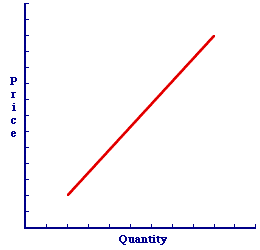
|
|
MARKET-BASED ECONOMY: A mixed economy that relies heavily on markets to answer the three basic questions of allocation, but with a modest amount of government involvement. While it is commonly termed capitalism, market-oriented economy is much more descriptive of how the economy is structure.
Visit the GLOSS*arama
|
|


|

|
                           COMPLEMENT-IN-PRODUCTION: One of two (or more) goods that are simultaneously produced using a given resource. A complement-in-production is one of two alternatives falling within the other prices determinant of supply. The other is a substitute-in-production. An increase in the price of one complement good causes an increase in supply for the other. Complements-in-production are two or more goods that are jointly produced using a given resource. The production of one good automatically triggers the production of another, often as a bi-product. Both goods are simultaneously produced from the same resource. The production of one good does not exclude the production of the other, as would be the case for substitutes-in-production. In fact, it promotes the production of the other. Produce one, produce both.Agricultural producers frequently generate bi-products when they produce a primary good, such as wheat and hay. Cattle ranchers produce both beef and leather from the same cattle resource. Lumber mills use timber resources to the produce two-by-fours and sawdust. The price of a complement-in-production is part of the other prices supply determinant. A change in the price of a complement-in-production causes a change in supply and a shift of the supply curve. An increase in the price of one complement good causes an increase in the supply of the other. A decrease in the price of one complement good causes a decrease in the supply of the other. Shifting the Supply CurveTo illustrate this process consider the simultaneous production of two goods--beef and leather. Each is jointly produced using the same cattle resources. When producers produce one, they produce both.Complement-in-Production
Leather | 
|
How is the supply of leather affected if the price of beef should change?- A Higher Price: Suppose the price of beef increases. Profit-minded cattle ranchers undoubtedly react according to the law of supply and increase the quantity supplied of beef. However, in that this generates leather as a bi-product, more leather is automatically produced. The result is an increase in the supply of leather and a rightward shift of the supply curve. Click the [Price Increase] button to demonstrate.
- A Lower Price: Suppose the price of beef decreases. Profit-minded cattle ranchers also likely react according to the law of supply and decrease the quantity supplied of beef. However, now there is less leather generated as a bi-product, with less leather automatically produced. The result is a decrease in the supply of leather and a leftward shift of the supply curve. Click the [Price Decrease] button to demonstrate.

Recommended Citation:COMPLEMENT-IN-PRODUCTION, AmosWEB Encyclonomic WEB*pedia, http://www.AmosWEB.com, AmosWEB LLC, 2000-2025. [Accessed: July 5, 2025].
Check Out These Related Terms... | | | | | | | |
Or For A Little Background... | | | | | | | | | |
And For Further Study... | | | | | | | | |
Search Again?
Back to the WEB*pedia
|



|

|
|
In the early 1900s around 300 automobile companies operated in the United States.
|

|
|
"Plans are only good intentions unless they immediately degenerate into hard work." -- Peter Drucker, management consultant
|

|
ES
Singapore Stock Exchange
|

|
|
Tell us what you think about AmosWEB. Like what you see? Have suggestions for improvements? Let us know. Click the User Feedback link.
User Feedback
|


|


